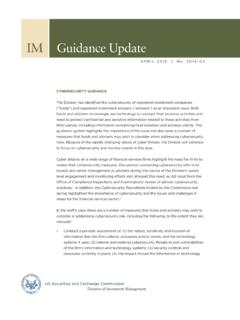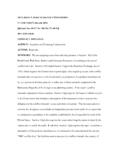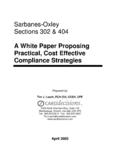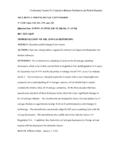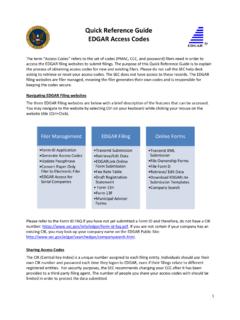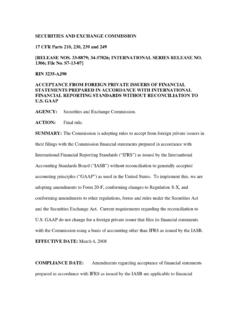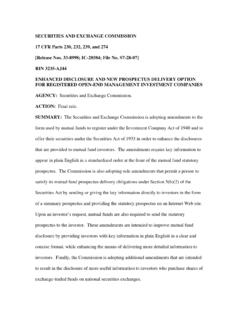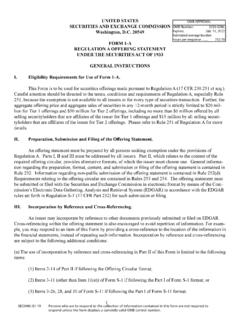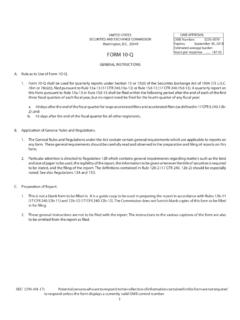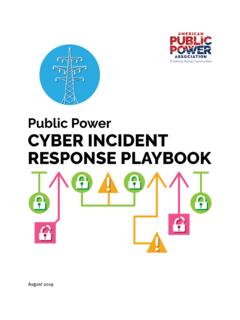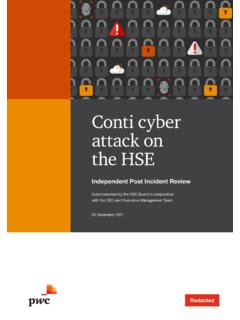Transcription of Conformed to Federal Register version - SEC
1 1 Conformed to Federal Register version SECURITIES AND EXCHANGE COMMISSION 17 CFR Parts 229 and 249 [Release Nos. 33-10459; 34-82746] Commission Statement and Guidance on Public Company Cybersecurity Disclosures AGENCY: Securities and Exchange Commission. ACTION: Interpretation. SUMMARY: The Securities and Exchange Commission (the Commission ) is publishing interpretive guidance to assist public companies in preparing disclosures about cybersecurity risks and incidents. DATES: Applicable: February 26, 2018 FOR FURTHER INFORMATION CONTACT: Questions about specific filings should be directed to staff members responsible for reviewing the documents the company files with the Commission. For general questions about this release, contact the Office of the Chief Counsel at (202) 551-3500 in the Division of Corporation Finance, Securities and Exchange Commission, 100 F Street NE, Washington, DC 20549.
2 SUPPLEMENTARY INFORMATION: I. Introduction A. Cybersecurity Cybersecurity risks pose grave threats to investors, our capital markets, and our 1 The Computer Emergency Readiness Team defines cybersecurity as [t]he activity or process, ability or capability, or state whereby information and communications systems and the information contained therein are protected from and/or defended against damage, unauthorized use or modification, or exploitation. Computer Emergency Readiness Team website, available at #C (Adapted from: CNSSI 4009, NIST SP 800-53 Rev 4, NIPP, DHS National Preparedness Goal; White House Cyberspace Policy Review, May 2 Whether it is the companies in which investors invest, their accounts with financial services firms, the markets through which they trade, or the infrastructure they count on daily, the investing public and the economy depend on the security and reliability of information and communications technology, systems, and networks.)
3 Companies today rely on digital technology to conduct their business operations and engage with their customers, business partners, and other constituencies. In a digitally connected world, cybersecurity presents ongoing risks and threats to our capital markets and to companies operating in all industries, including public companies regulated by the Commission. As companies exposure to and reliance on networked systems and the Internet have increased, the attendant risks and frequency of cybersecurity incidents also have Today, the importance of data management and technology to business is analogous to the importance of electricity and other forms of power in the past century. Cybersecurity incidents3 can result from unintentional events or deliberate attacks by insiders or third parties, including cybercriminals, competitors, nation-states, and hacktivists.
4 4 Companies face an evolving 2009). 2 See World Economic Forum, Global Risks Report 2017, 12th Ed. (Jan. 2017), available at (concluding that greater interdependence among different infrastructure networks is increasing the scope for systemic failures whether from cyber-attacks, software glitches, natural disasters or other causes to cascade across networks and affect society in unanticipated ways. ). See also PwC, Turnaround and Transformation in Cybersecurity: Key Findings from the Global State of Information Security Survey 2016 (Oct. 2015), available at (finding that in 2015 there was a reported 38% increase in detected information security incidents from 2014).
5 3 A cybersecurity incident is [a]n occurrence that actually or potentially results in adverse consequences to .. an information system or the information that the system processes, stores, or transmits and that may require a response action to mitigate the consequences. Computer Emergency Readiness Team website, available at #I. 4 One study using a sample of 419 companies in 13 countries and regions noted that 47 percent of data breach incidents in 2016 involved a malicious or criminal attack, 25 percent were due to negligent employees or contractors (human factor) and 28 percent involved system glitches, including both IT and business process failures. See 3 landscape of cybersecurity threats in which hackers use a complex array of means to perpetrate cyber-attacks, including the use of stolen access credentials, malware, ransomware, phishing, structured query language injection attacks, and distributed denial-of-service attacks, among other means.
6 The objectives of cyber-attacks vary widely and may include the theft or destruction of financial assets, intellectual property, or other sensitive information belonging to companies, their customers, or their business partners. Cyber-attacks may also be directed at disrupting the operations of public companies or their business partners. This includes targeting companies that operate in industries responsible for critical infrastructure. Companies that fall victim to successful cyber-attacks or experience other cybersecurity incidents may incur substantial costs5 and suffer other negative consequences, which may include: remediation costs, such as liability for stolen assets or information, repairs of system damage, and incentives to customers or business partners in an effort to maintain relationships after an attack;6 increased cybersecurity protection costs, which may include the costs of making organizational changes, deploying additional personnel and protection technologies, training employees, and engaging third party experts and consultants.
7 Ponemon Institute and IBM Security, 2017 Cost of Data Breach Study: Global Overview (Jun. 2017), available at 5 The average organizational cost of a data breach in the United States in 2016 was $ million based on the sample in the study. Id. However, the total costs a company may incur in connection with a particular cyber-attack or incident could be much higher. 6 A company s costs may also include payments to perpetrators of ransomware attacks in order to attempt to restore operations or protect customer data or other proprietary information. But see Federal Bureau of Investigation, How To Protect your Network from Ransomware, Ransomware Prevention and Response for CISOs, available at 4 lost revenues resulting from the unauthorized use of proprietary information or the failure to retain or attract customers following an attack; litigation and legal risks, including regulatory actions by state and Federal governmental authorities and authorities;7 increased insurance premiums; reputational damage that adversely affects customer or investor confidence; and damage to the company s competitiveness, stock price, and long-term shareholder value.
8 Given the frequency, magnitude and cost of cybersecurity incidents, the Commission believes that it is critical that public companies take all required actions to inform investors about material cybersecurity risks and incidents in a timely fashion, including those companies that are subject to material cybersecurity risks but may not yet have been the target of a cyber-attack. Crucial to a public company s ability to make any required disclosure of cybersecurity risks and incidents in the appropriate timeframe are disclosure controls and procedures that provide an appropriate method of discerning the impact that such matters may have on the company and its business, financial condition, and results of operations, as well as a protocol to determine the potential materiality of such risks and In addition, the Commission believes that the development of effective disclosure controls and procedures is best achieved when a company s directors, officers.
9 And other persons responsible for developing and overseeing such controls and procedures are informed about the cybersecurity risks and incidents that the company has 7 See, , New York State Department of Financial Services, 23 NYCRR 500, Cybersecurity Requirements for Financial Services Companies; European Union General Data Protection Regulation, Council Regulation 2016/679, 2016 (L 119) 1. 8 See Section below for further discussion of disclosure controls and procedures. 5 faced or is likely to face. Additionally, directors, officers, and other corporate insiders must not trade a public company s securities while in possession of material nonpublic information, which may include knowledge regarding a significant cybersecurity incident experienced by the company.
10 Public companies should have policies and procedures in place to (1) guard against directors, officers, and other corporate insiders taking advantage of the period between the company s discovery of a cybersecurity incident and public disclosure of the incident to trade on material nonpublic information about the incident , and (2) help ensure that the company makes timely disclosure of any related material nonpublic In addition, we believe that companies are well served by considering the ramifications of directors, officers, and other corporate insiders trading in advance of disclosures regarding cyber incidents that prove to be material. We recognize that many companies have adopted preventative measures to address the appearance of improper trading and we encourage companies to consider such preventative measures in the context of a cyber event.
